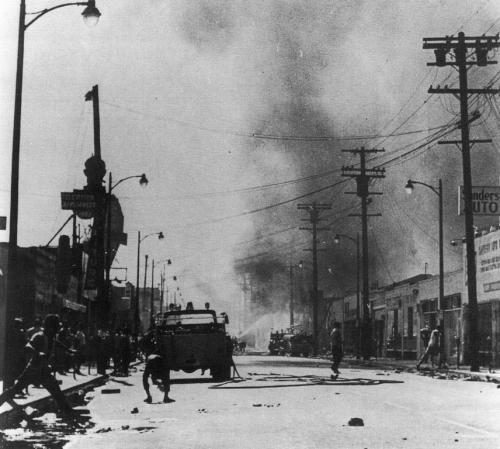Watts Rebellion (August 1965)

103rd Street, Watts Riot, 1966
Image Ownership: Public Domain
However they found both in the west. For many black Los Angeles residents who lived in Watts, their isolation in that community was evidence that racial equality remained a distant goal as they experienced housing, education, employment, and political discrimination. These racial injustices caused Watts’ African American population to explode on
August 11, 1965 in what would become the Watts Rebellion.
The rebellion began on August 11th when the Los Angeles Highway Patrol stopped black Watts resident Marquette Frye and his brother, alleging that they were speeding. Back-up was called from the Los Angeles Police Department (LAPD) as a crowd of African Americans gathered to watch the scene. Since the incident was close to Frye’s home, his mother emerged to find her son resisting arrest. Fearful that his arrest may ignite a riot, one LAPD officer drew his firearm. Catching a glimpse of the gun, Mrs. Frye jumped onto the officer’s back, causing the crowd to begin cheering. Los Angeles Police Department (LAPD) officers arrested all three of the Fryes. Enraged by the family’s arrests, Watts’ residents protested as the police cars drove away. Less than an hour later, black Angelenos took to the streets.
The five day revolt which involved some 30,000 people served as stark testimony to the inequality and poverty that dominated the lives of thousands of Watts’s residents.
Many of those engaged in the uprising looted items from local groceries and clothing stores, acquiring what they wanted and needed but often could not afford. Others battled the
LAPD which they held immediately responsible for their poverty and alienation.
By August 15 the riot ended when 14,000 National Guard troops arrived and patrolled the streets. The following day most African Americans retired to their homes. In the end, the Watts Rebellion took 34 lives. There were 1,032 injuries, nearly 4,000 arrests and $40 million dollars in property damage. In spite of the protest, the Watts Rebellion did not significantly improve the lives of the community’s black population. While the revolt inspired the federal government to implement programs to address unemployment, education, healthcare, and housing under Lyndon B. Johnson’s “War on Poverty,” much of the money allocated for these programs was eventually absorbed by the Vietnam War. Today most of the population of Watts is Latino with many residents from the Central American countries of El Salvador, Guatemala and Honduras. Although the population has changed, many of the issues of poverty, alienation and discrimination still plague the community today.
Sources:
Gerald Horne. Fire This Time: The Watts Uprising and the 1960s (Charlottesville: University Press of Virginia, 1995); Josh, Sides. L.A. City Limits: African American Los Angeles from the Great Depression to the Present (Berkeley: University of California Press, 2003; Governor’s Commission on the Los Angeles Riots. Violence in the City—an End or a Beginning? (Los Angeles: Governor’s Commission on the Los Angeles Riots, 1965).
Contributor:
University of Washington
University of Washington
No comments:
Post a Comment
Please leave your ideas